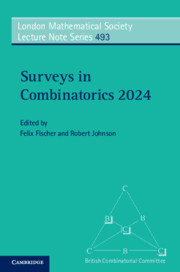Book contents
- Frontmatter
- Contents
- Preface
- Intersection Theory of Matroids: Variations on a Theme
- Erdős Covering Systems
- The Cluster Expansion in Combinatorics
- Sublinear Expanders and Their Applications
- Transversals in Latin Squares
- Finite Field Models in Arithmetic Combinatorics – Twenty Years On
- The Slice Rank Polynomial Method – A Survey a Few Years Later
- An Introduction to Transshipments Over Time
- Oriented Trees and Paths in Digraphs
- References
Transversals in Latin Squares
Published online by Cambridge University Press: 23 May 2024
- Frontmatter
- Contents
- Preface
- Intersection Theory of Matroids: Variations on a Theme
- Erdős Covering Systems
- The Cluster Expansion in Combinatorics
- Sublinear Expanders and Their Applications
- Transversals in Latin Squares
- Finite Field Models in Arithmetic Combinatorics – Twenty Years On
- The Slice Rank Polynomial Method – A Survey a Few Years Later
- An Introduction to Transshipments Over Time
- Oriented Trees and Paths in Digraphs
- References
Summary
A Latin square is an n by n grid filled with n symbols so that each symbol appears exactly once in each row and each column. A transversal in a Latin square is a collection of cells which do not share any row, column, or symbol. This survey will focus on results from the last decade which have continued the long history of the study of transversals in Latin squares.
Information
- Type
- Chapter
- Information
- Surveys in Combinatorics 2024 , pp. 131 - 158Publisher: Cambridge University PressPrint publication year: 2024
References
Accessibility standard: Unknown
Why this information is here
This section outlines the accessibility features of this content - including support for screen readers, full keyboard navigation and high-contrast display options. This may not be relevant for you.Accessibility Information
- 1
- Cited by
